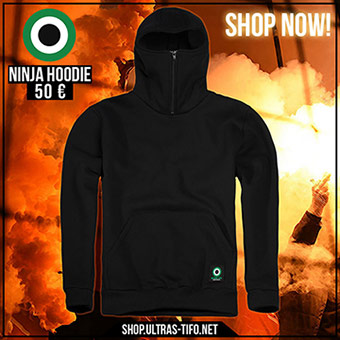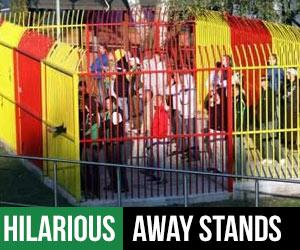Want to buy pyrotechnics? Visit pyro.ultras-tifo.net
 Interview about the Russian supporter-scene.
Interview about the Russian supporter-scene.
-When did fan culture appear in Russia, and how was it exhibited?
Like in England, first football connected violence appeared long before the first steps of the fan culture. Overturned cars and broken glasses of the trams after football matches were an ordinary thing for Moscow and Leningrad (soviet name for Saint-Petersburg). Football was very significant kind of sport for the Soviet Union, so despite huge international success in hockey, all big stadiums in USSR were completely full. In 1970-80es first fans appeared, they were getting together into small groups at the stadium. During those times all club stuff was a thing to be proud of, all scarves (or “roses” in Russian fans’ slang) and pullovers, designed in club’s colors (“pulsers”) were handmade. For every “abnormal” thing (pin, flag, scarf) you could be arrested easily, even before reaching the stadium.
Country was behind “the iron curtain” and information was thoroughly collected and spread between small-numbered fans all over the huge USSR territory.
First fans who began to organize trips to away games and vocal support were Spartak Moscow fans, people from other cities and regions followed their example.
Characteristic feature of this time was brotherhood between all fans, it was this feature, that explained existence of the fan culture itself.
Support of the team consisted of little, not taken from the club flags and short, simple songs. Such behavior wasn’t understandable either for cops or for ordinary football lovers.
-Were they groups of people, who started organized support and began creating atmosphere, after looking on Europe?
Certainly, first experience was taken from those miserable pieces of information, which infiltrated into the country; something was taken from newspaper articles and photos. Film “Ultra” influenced on our fan culture development greatly, motives of songs from this film can be still be heard on many tribunes. It was “childhood” of our fan culture, and we more learned and took from the others then invented something ourselves. Bright example is song, devoted to “Liverpool” fans, now such things are impossible.
-When did the first ultras appear in Russia?
It depends on what do you consider to be “ultras”. First group, which was the most suitable for this term was Spartak’s “Flint’s Crew”. But response from the other sides appeared quickly. It were 1990es, violence and gangster-ism were widespread all over the country, that period can be called the rise of the modern hooliganism, which later grew into the Russian Style. It wouldn’t be easy to trace all events of that time, but various fanzines appeared. Except Flint’s Crew other significant for Russian scene groups were: Red-Blue Warriors (CSKA), BWD (Dynamo) and Nevsky Front (Zenit).
-How do the government and police react on the popularity and development of the Russian ultra?
After 90es, situation in the country got normal, people could live without thinking of everyday troubles, and fan movement rose greatly. Only person, absolutely not interested in football, wasn’t aware of fans existence, that they were numerous and powerful. Many new people start attending tribunes, and this caused many initial troubles. But movement became much stronger, and government couldn’t ignore it anymore. By the middle of 2000es, clubs and police start their attempts to integrate fans into society. They allow many massive choreo`s.
Russia is a huge country, and whether in big cities police is more loyal, when you are on tour in some distant region, you can face causeless police brutality. One is for sure – special troops’
Batons are as firm in Vladimir or Vladivostok, as in Zagreb or Turin
CSKA fans vs ACAB in Yaroslavl:
{youtube}tczMuGM2mkA{/youtube}
Zenit vs ACAB (1):
{youtube}iPMFwCp_p1E{/youtube}
Zenit vs ACAB (2):
{youtube}OjBYswsVO4w{/youtube}
Spartak Hools in Prague:
{youtube}7sBcxjby67Q{/youtube}
-Which ultra group is now the strongest and the most active in Russia?
Many groups can exist inside one movement in Russia. At the moment Spartak, Zenit CSKA and Lokomotive are nearly on the same level. Noticeable progress in the regions can be named as well.
But we cannot mark anybody concrete, because final steps to domination on ultra scene were not made yet.
-Tell us about friendship and rivalry between Russian fans.
Usually rivalry and friendship between clubs is based on social roots. There is huge religious distrust between Orthodox Christians and Moslem's. There are no serious wars, but these groups will never be friends and are always ready to show their aggression. Confrontations between cities inside one region are also worth to mention, bright example is Moscow and Saint-Petersburg situation. Every match between Zenit and Moscow teams is “high risk category game” as the cops say. But there are other single conflicts, based on social reasons, for example Spartak vs CSKA and Dynamo, Zenit vs Spartak and Dynamo. These matches are may be the “hottest” games in the country. Serious friendships exist as well, especially in the regions, where fans are eager to help each other and it lead to long and firm relations.
If describing more thoroughly, it can take many time, it is better to ask about every club separately.
Also there exists confrontation between former USSR republics, for example game of every Russian team in Baltic countries is a “flashback” into USSR, when Russian fans were always attacked by local nationalists, and fights were extremely brutal.
Motorcycle chains and broken glass were usual for those fights.
As for Ukraine, relations are complicated; many links between Russian and Ukrainian movements are lost, but such rivals as Spartak – Dynamo Kiev remained the same.
Zenit in Moscow:
{youtube}H5DMr4qV2pA{/youtube}
Lokomotiv in Saint-Petersburg. Guest sector:
{youtube}Roah9u5DORo{/youtube}
-How do cops and authorities react on pyro? What punishments for pyro are there in
Russia?
Initially, since 90es, pyro became indispensable part of tribune, but the time flies, cops are getting more experienced, taking pyro on tribune is harder and harder, cameras and dogs do their job. Big movements can arrange pyro shows with their club management. But since this year new law about pyro, that directly forbids pyro “in places of massive people concentration”. It seems, that there will be many problems with cops in the new season. New law makes their job easier, and now pyro is not a “petty crime” any more, but a serious violation of the law.
Spartak hools vs ACAB:
{youtube}1A3X1zzpBcQ{/youtube}
{youtube}dvSAuKybkhc{/youtube}
-What are Russian fans’ political views?
Usually Russian fans are right-winged, even those, who consider themselves to be “apolitical”. There exist left winged groups, but they are miserable and little numbered. Left oriented people became “non persons”, also there are national restrictions in groups, even though it is not easy to make in country with such variety of nations. Many fans take part in nationalistic actions and movements, not like in Italy for example, where you can declare your views openly, but people work on agitation right views and ideas.
Many groups were marked as sympathizing to fascism, Spartak and Zenit are main newsmakers there. In general Russia is a cold country and nigger’s life is not easy here =)
Right hools Rubin Kaza:
{youtube}qxP8tqp0GqQ{/youtube}
Right Russian hools in Azerbaijan vs Muslims:
{youtube}N0ra4W_j2ew{/youtube}
-Describe Russian ultras-movement in general.
In such a huge country as Russia any development cannot be the same in different parts of the country and distant from the European part regions are far behind in their development. Firstly it is subject to people, who accept ultras ideology. In Russia authorities were indifferent towards the fan culture for a long time, and ultras development wasn’t under such a high pressure as in the other countries. Whether in big cities movement easy progressed (links with the Europe, many people on tribunes), in regions people have to create such positive conditions themselves.
Sometimes fans even have to make advertisements about their club and take control over the club’s existence. Administration of such towns can easily rename clubs, change colors and emblems, proving it by economical profits, sometimes it may touch even such famous in the past clubs (and fan movements) as Torpedo Moscow.
Nowadays few movements have wars with their club’s clones or/and artificially made clubs in their town, they destroy these clubs advertisement, make graffiti and stickers in honor of their club.
Development of such outnumbered movements takes place in harsh conditions of struggle for existence, and we can say, that their model is the closest to the classical ultra. They do not have any agreements with club management, they usually as management things “make club only harm”, cops do not consider them to be people, and use their entire arsenal, from ordinary violence to 15 days in prison, under various excuses.
Recent example – Tatarstan (Moslem's republic inside the Russian Federation) police captured fans of FC Kryla Sovietov from Samara for the whole weekend, and some people were taken to the prison for 2 month after troubles on the stadium.
Samara in Kazan vs ACAB (1):
{youtube}EG2NJ7Ci5Wk{/youtube}
Samara in Kazan vs ACAB (2):
{youtube}p0sziIbTcS0{/youtube}
Spartak fans protest against the club:
{youtube}pGaVvHrpiJE{/youtube}
Thanks to www.russian-ultras.com for this interview!










